Video conference 1 Feb 2018 - Citizen Science
SWIFFT video conference notes are a summary of the video conference and not intended to be a definitive record of presentations made and issues discussed.
This video conference was supported through resources and technology provided by the Department of Environment, Land, Water and Planning, Victoria. SWIFFT wishes to thank speakers for their time and delivery of presentations. Thanks to Craig Whiteford who chaired the session from Ballarat.
The first video conference for 2018 had a theme: Citizen Science.
Key points summary
Quick take home messages from this video conference or
Presentations
- Rewilding the Desert
- NatureWatch
- 'Where's Lori' - Exploring how to build participation in citizen science
- 'Rec fishers fishing for fish earbones’
- South East Australian Photo Identification Catalogue - Southern Right Whales
Atotal of 130 participants were connected across 16 locations; Ararat, Ballarat, Benalla, Bendigo, Colac, Geelong, Hamilton, Heywood, Horsham, Heidelberg (Arthur Rylah Institute), Lonsdale Street (Melbourne), Knox (Melbourne), Mildura, Orbost, Warrnambool and Wodonga.
A trial webinar was also conducted at selected sites.
List of groups/organisations in attendance
Educational: Federation University, Deakin University
Local Government: Banyule City, Yarra Ranges Shire, Hume City.
Field Naturalist Clubs: Ballarat, Bendigo, Hamilton, Portland, Geelong and Bairnsdale.
Community Conservation Groups: Birdlife Hamilton, Ballarat Environment Network, Friends of Eastern Otways, Kowree Farm Tree Group, BG Landcare, Connecting Country, Moorabool Landcare, Napoleons/Enfield Landcare, Wombat Forestcare, Wedderburn Conservation Management Network, Moorabool Landcare, Pallisters Reserve (Warrnambool), Australian Plant Society (Warrnambool), Regent Honeyeater Project.
Conservation Organisations: Waterwatch, Dolphin Research Institute, Conservation Volunteers Australia (Little Desert re-wilding), Victorain National Parks Association, Coastcare, Glenelg Hopkins CMA, West Gippsland CMA, Wimmera CMA, Parks Victoria (Orbost, Otways), Geelong Native Title, Winda-Mara Aboriginal Corporation, Victorian Volcanic Plains Biosphere, Native Fish Australia, Department of Education & Training (Koorie engagement support officer, Orbost), Department of Environment, Land, Water and Planning (DEWLP) staff across 18 locations, inc. Lonsdale Street and Arthur Rylah Institute, Heidelberg.
Industry: ABZECO Pty Ltd, Streamline Research Pty Ltd, Wild Days Wildlife Shelter and Coliban Water.
Private individuals: x 4
Presentation summaries
Rewilding the Desert - Ben Holmes, Program Manager – Threatened Species & Rewilding Project, Conservation Volunteers Australia
Ben provided a brief introduction to Conservation Volunteers Australia (CVA) established in 1982 at Ballarat, now with 25 offices across Australia and New Zealand. CVA engages communities to participate in projects that protect and enhance the environment and is a leader in practical conservation.
About Rewilding
Ben explained that Rewilding is landscape scale conservation aimed at recreating or restoring self-regulating, sustainable ecosystem that requires little to no human intervention to manage. This is achieved by reintroducing missing wildlife – particularly highly functions species such as predators or ecosystem engineers.
The project will initially focus on three CVA properties totalling Approx. 1500 Ha primarily managed for conservation.
- The Malleefowl Sanctuary (predator proof fenced).
- The Little Desert Nature Lodge (predator proof fenced).
- Salvana Conservation Reserve.
The project is based at the Little Desert Nature Lodge which also has accommodation, event and function facilities.
 Slide 1 map
Slide 1 map
Achieving a landscape scale approach involves various land managers such as Parks Victoria, DELWP, landholders and conservation organisations in the Wimmera. The project also has a partnership with Fauna Research Alliance and will use Citizen Science to assist in surveys and monitoring.
Key objectives
- Threatened species conservation (reintroduction of threatened species).
- Rewilding proof-of-concept (rigorous monitoring and research program to measure the benefits of reintroductions to local ecosystems).
- Rewild people (connecting people with nature via Citizen Science also through education and engagement using the Little Desert wildlife aviary). The Little Desert Nature Lodge also plays a role in providing a venue where people can be in close contact with nature.
Baseline monitoring program
Citizen Science (Community & Volunteer Delivery Model) has been used for the base line monitoring program. The aim was to develop methods and protocols which can be adapted to different situations and tested within and outside the predator proof areas. This involves pitfall trapping, cage trapping, funnel trapping, habitat surveys, soil surveys and camera monitoring surveys.
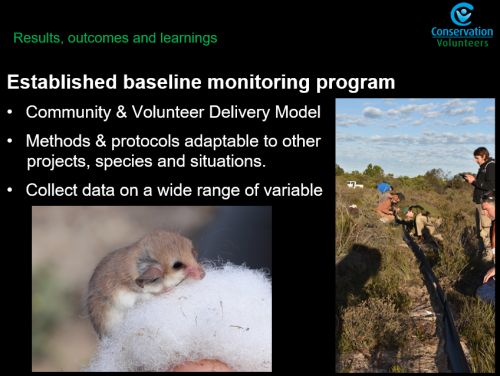
To-date the Community and Volunteer Delivery Model has been very successful with 34 long- term monitoring sites established with 5844 trap days and 7640 trap nights, Approx. 27 species of animals have been recorded. The model could easily be adaptable to other situations.
Preliminary results indicate more mammals have been captured inside the fenced areas than outside the fence some examples include; no Brush-tailed Possums caught outside the fence but plenty inside the fence, for Silky Mice 5 times more caught inside the fence compared with outside the fence. Pygmy Possum numbers are similar inside vs outside the fence.
Research and reintroduction programs

Reintroductions are the next phase of the Rewilding project expected to commence in the next 12-18 months. A small reintroduction trial into one of the smaller predator proof areas will be first to ensure processes are right. Further reintroductions will focus on Digger species then after monitoring reintroductions of Predator species and insectivore species.
Research will involve Citizen Science but for the more technical and complex research the project will engage the fauna research scientists, PhD and honours students.
Getting involved
Ben spoke about a number of ways people can participate in Rewilding. There are numerous volunteering options involving practical hands on monitoring. People can stay at the Little Desert Lodge. Funds from stays at the lodge are directed back to the Rewilding program. People can also help by spreading the word about the program and make tax free donations towards the project. www.littledesertlodge.com.au/conservation/

Citizen Science (Community & Volunteer Delivery Model) provides opportunities for people to engage with nature.
Seeing wildlife close up
Ben said one of the exciting things ahead will be for people to stay in comfort at the lodge, enjoy good food and refreshments whilst having the opportunity to experience nature and see animals that have been extinct in the area for over 100 years.
Contact: Ben Holmes +61 (0) 475 973 884
Key points from questions
- Invertebrate monitoring has not been carried out yet but rather the abundance of species feeding on insects has been monitored. Monitoring of insect abundance would be good into the future but subject to input of people with the right expertise.
- The diversity of CVA volunteers tends to be young people or retirees with low numbers of people in the middle. Many University students volunteer to gain practical skills.
- Data from surveys will eventually be made available to the Victorian Biodiversity Atlas.
- Protection of orchids from digging species will focus on only a few remaining sites where there may be a need to provide small scale protective fencing.
- Animals for reintroduction will be sourced from other free range enclosures around Australia where numbers permit.
- The new VBA mobile go App will assist people in submitting records.
- Citizen Scientists are motivated by being able to connect with nature, particularly as we live in a more urbanised environment.
Hear Ben Holmes talking about Rewilding the Desert project.
NatureWatch - Christine Connelly , NatureWatch Coordinator & Victorian Chapter Australian Citizen Science Association
Christine co-ordinates the NatureWatch program for the Victorian National Parks Association.
Christine spoke about the growing momentum of Citizen Science and reminded us there are a number of people who are already doing this type of activity but under other names, e.g. when NatureWatch started in 2007 it was called Community based monitoring.
Overview of Victorian National Parks Association
The VNPA was set up in 1952 and is one of Victoria’s oldest conservation organisations. The VNPA is now a leading voice for nature conservation in Victoria. It is not-for-profit, being supported through memberships and donations.
The VNPA vision; Victoria is a place with a diverse and healthy natural environment protected, respected and enjoyed by all.
Main focus areas
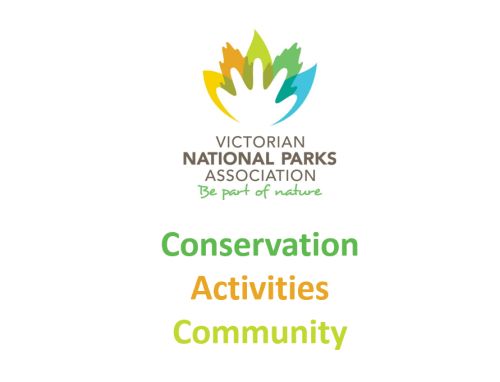
Nature Conservation – advocacy and campaign work, promoting the development of thoughtful policies towards nature conservation. Supporting and undertaking scientific research. Supporting the Vic Nature 2050 initiative re climate change and native species in Victoria.
Activities -. Engaging Victorian’s with nature through bushwalking, excursions and restoration activities.
Community - educating empowering people to take part in nature conservation e.g. ParkWatch, ReefWatch, NatureWatch.
NatureWatch
The VNPA brings together land managers, scientists and the community to initiate, develop and implement their own community lead Citizen Science projects.
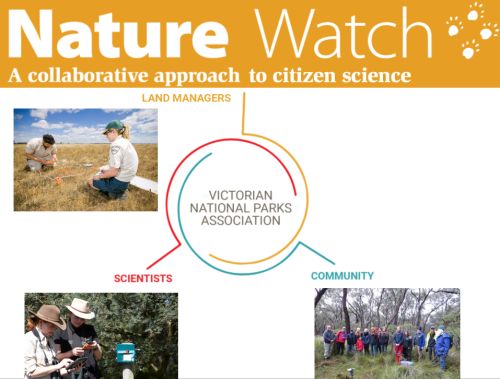
Three-way learning and engagement is a key aspect in the success of NatureWatch projects (Scientists - Community - Land Managers).
Christine spoke about the way Team Leadership builds expertise within communities to help communities. Expert volunteers train and lead other volunteers building enhanced knowledge base for community projects.
Grasstree monitoring project – launched in 2007 at the Brisbane Ranges National Park. This project now undertakes long term monitoring of quadrats at a number of selected sites within three Parks affected by Phytophthora cinnamomi dieback. Volunteers assess the health of every single grasstree within a quadrat, soil samples are also taken to detect the Phytophthora pathogen. Christine emphasised the long-term partnerships established with conservation groups and Deakin University.
Grassland and threatened species project – monitoring threatened species in native grasslands e.g. Plains Yam Daisy, Striped Legless Lizard, Growling Grass Frog, Golden Sun Moth, and Spiny Rice-flower. This type of monitoring tends to attract more short-term engagements from people involved.
Caught on Camera – this project commenced in 2012 in the wombat State Forest and involves using motion sensing cameras to monitor wildlife. The project has since been extended to six locations for specific purposes e.g. studying impacts and ecosystem recovery post fire, also wildlife in revegetation projects. An important aspect of the project is bringing together the land manager with local community groups and scientist to share what they want out of the project and plan the monitoring.
Communities listening for nature – commenced in 2015, uses bioacoustics to monitor birds. This project is supported through the Helen MacPherson-Smith Trust. Automatic recorders are used by community groups to detect various species of birds at four locations. Museums Victoria is also involved in development of a Library of Victorian Bird Calls.

Citizen Science theory
Christine spoke about the types of Citizen Science projects; Contributory, Collaborative or Co-created. At one end of the scale projects can be run exclusively by scientists where people contribute data. At the other end of the scale are projects run in partnership with citizen scientists.

Australia Citizen Science Association (ACSA)
The ACSA was formed in 2004. Its aim is to advance citizen science through sharing of knowledge, collaboration, capacity building and advocacy for citizen science. It is a member-based community that supports, informs and develops citizen science. Membership open to project managers, volunteers or anyone interested in citizen science.
Australia Citizen Science Association
Australian Citizen Science Project Finder
Australia Citizen Science Association (ACSA) Victorian Chapter
The Victorian chapter idea was formed in 2015 and has since attracted several organisations such as EPA, VNPA, Museum Victoria, Melbourne Water and The Royal Society of Victoria. The primary benefits are the meeting and sharing, talking and networking representing the interests of people in Victoria involved in Citizen Science.
Victorian National Parks Association
Key points from questions
The results from grasstree monitoring at Point Addis are not out yet but will be finalised in the near future. The report is likely to reveal that there was no increase in Phytophthora. Sign up to the VNPA newsletter for report release.
At this stage NatureWatch projects are set up with existing community groups which may or may not have linkages with Traditional owners but no specific targeting of Traditional owners has been undertaken as yet. NatureWatch would be very willing to work with Traditional owners.
Bioacoustic recordings of birds will be made available via the Museums Victoria – Collections on-line.
‘Where’s Lori?’ Exploring how to build participation in citizen science - Fern Hames & Students, Arthur Rylah Institute (ARI)
Fern introduced the topic by talking about what Citizen Science means for the Department of Environment, Land, Water & Planning. Essentially, volunteers partnering with scientists to build knowledge to answer a scientific question. This is particularly relevant for ARI which is a scientific institution and interested in generating science & knowledge as well as guide policy and actions for biodiversity.
ARI and Citizen Science
ARI is interested to develop synergies and alignments
- Connect with community (ideas, skills, views)
- Grow scientific/ecological literacy
- Grow awareness, visibility, advocacy
- Shared approach to conservation & science
- Drive increased participation in Citizen Science
The increased emphasis on Citizen Science aligns well with Victoria’s new Biodiversity Plan 2037 key goals
- Victorians value nature
- Victoria’s natural environment is healthy
Fern spoke about ‘community involvement’ which has been around for many years prior to it being termed Citizen Science. In the past, community involvement tended to be more ad hoc and project driven but with new technologies Citizen Science has become more Strategic, Linked, Connected and Evaluated.
ARI are interested to know more about the linkages and dependencies between connecting Victorian’s with nature and behavioural change to support biodiversity. A Monash University Behaviour Change PhD project will focus on this work.
‘Where’s Lori?’ project
This was a short-term project which stemmed from work between ARI and Monash University Honours students who were looking at some of the motivations for people to get involved in Citizen Science and ways to increase the reach for connecting people with nature.
- How to grow the participation in Citizen Science?
- How could it be used to drive behaviour change in the connection with nature?
- Explore the role of rewards and technology?
Fern acknowledged the work by Charlie Medic and Cassandra Nolan from Monash University.
The project focused on identifying where Rainbow Lorikeets are nesting around Victoria. The team knew Birdo’s would be interested but more importantly they wanted to test if incentives and technology would bring in those people not yet connected to nature.

People were asked to upload photos of Rainbow Lorikeets using nest hollows and complete baseline questions. It was important to have constant conversation, posts online, video, enriched with other more traditional forms of promotion such as radio.

Social media platforms were set up to engage with people (Facebook, Instagram and Twitter).
The team had a good response with an abundance of participants providing numerous high quality images and data. The value of data was very good and very useful in understanding where Lorikeets were and the type of hollows they were using which was new information about the species.
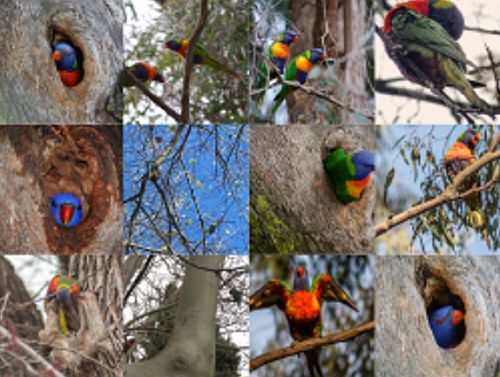
Numerous high quality images and data was provided through Citizen Science.
Evaluating the role of social media
The age profile of people engaged in this project was 18-69 years, slightly more females than males. Social media proved to be an effective means of collecting valid data for this project. It was also an effective means of connecting with people naïve to nature. Facebook was the most popular platform used by people in this project. It also provided opportunities to link in with other existing networks thereby expanding the project’s reach.
Social media technology provides opportunities for instant feedback and connectivity to participants. The use of video clips was considered to be a success.
Trying to work out if an app-based Citizen Science project is better than one that isn’t still requires more research. Many respondents were unsure of what other options may exist. The use of apps could depend on the type of project and evaluation requires a larger sample over time.
Offering rewards and prizes appeared to increase activity but offerings need to be targeted to match the interests of the audience. People tended to be involved not because of rewards but for other reasons e.g. like of Lorikeets or birds, connection to project and having some fun.
Connection to nature
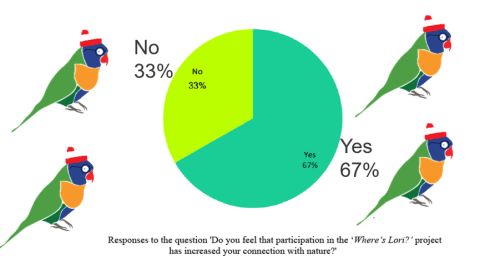
Response to the question ‘Do you feel that participation in the ‘Where’s Lori’ project has increased your connection with nature?
Fern emphasised this type short term ‘case study’ type project did not involve large numbers of people but did provide some indication that people can connect with nature at a range of levels. Projects such as ‘Where’s Lori’ can be a stepping stone in connecting people with nature.
‘Rec fishers fishing for fish earbones’ - Pam Clunie (ARI)

Pam spoke about opportunities for Anglers and Scientists to work together in Citizen Science. There is increasing interest in volunteers getting involved in scientific research and monitoring. With new technologies data is easier to collect and verify providing greater scientific accuracy of data. Citizen Science can fill specific knowledge gaps to supplement existing studies which can save time and money.
The value of engaging with the community in science has many benefits e.g. improved scientific literacy, interest and trust. Citizen Science can increase the participants’ awareness of environmental issues, promote issues, and foster local stewardship.
Citizen science is flagged in 2 key Victorian plans:
Citizen Science and fish
Most of the Citizen Science relating to fish is Contributory – where scientists ask the public to collect/contribute data and/or samples for a project. This can be in relation to both Commercial and Recreational fishers. Some examples for recreational fishing;
- ‘Great Victorian Fish Count’ - snorkelers and divers providing data.
- Mulloway - tagging, otoliths etc. (Nature Glenelg Trust).
- Fishcare (Community organisation – educate, promote, volunteer).
- I Spy Fish app (Goulburn Broken CMA).

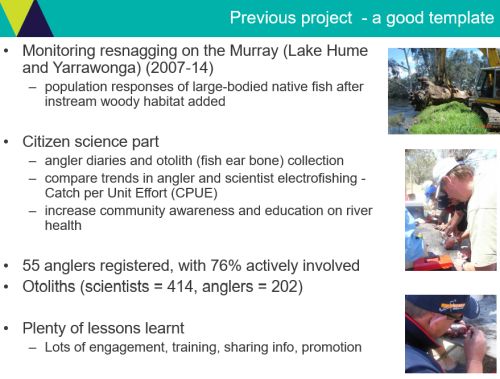
Using Otoliths
Otholiths are taken out of fish and used to determine the age of the fish from growth rings. They are an important means of understanding the structure of fish populations.
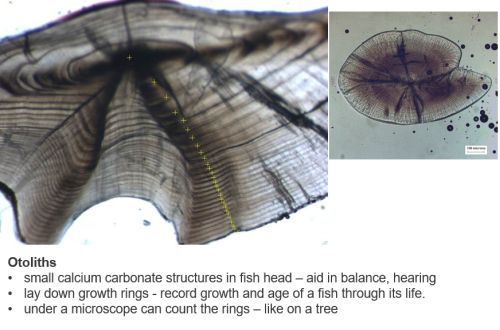
Victorian Environmental Flows Monitoring and Assessment Program
Pam spoke about applying Citizen Science to this program which has been running since 2005. Stage 6 of the project will run from 2017 – 2020 with very specific questions for key indicator species, in specific rivers in southern and northern Victoria. Fish monitoring employs a variety of techniques including using otoliths to determine the age structure of the fish population, rate of survival, stocked or not and movement history of fish. This information can be linked with management actions such as environmental flows.
Anglers can play an important role when they catch and keep fish (Murray Cod and Golden Perch) by providing otoliths for analysis.
Benefits of Citizen Science to this project
Provides a meaningful, satisfying citizen science program for anglers.
Increases angler and broader community awareness of: the VEFMAP program – what we are doing, how and why.
Helps anglers to understand the benefits of environmental water and the information used to help environmental flow decisions.
Improved knowledge regarding species’ ecology – anglers love hearing about their fish (e.g. ARI tag return database).
Build angler and broader community support for environmental water delivery.
Building Citizen Science into the program
Pam spoke about building partnerships with key organisation such as the Victorian Fisheries Authority, Catchment Management Authorities, angling groups etc. The project will be promoted using flyers, newsletters, magazines and social media.
Once participants are registered local events will be organised combining training on how to remove otoliths. Sharing progress regularly with participants is important as well as evaluation of the citizen science element of the project.
Evaluation of Citizen Science
Pam spoke about the types of things to be evaluated as the project proceeds and at the end.
From a science aspect – the number of otoliths analysed and how many from anglers and scientists.
From a participant aspect – the number of participants, how long they remained involved etc. Their satisfaction in project and awareness of environmental water, its benefits, VEFMAP, science more broadly and if they were more likely to participate in future citizen science activities.
A suite of approaches will be used to gain participant feedback including pre and post involvement questionnaires/interviews (including self-assessments of skills).
Contact: Pam Clunie for further details or interest in the project.
Key points from questions
The target fish species for Citizen Science are Murray Cod and Golden Perch but there is potential for other projects to include other species using the otolith method.
The Federation of Victorian Traditional Owner Corporations will be contacted to seek their involvement with this project.
People involved in Otolith collection usually have some training regarding how to cut them out. Submitted otoliths also need to be accompanied by data about the location, species, length of the fish, and submitter details.
Citizen Science and the South East Australian Photo Identification Catalogue (SEA SRW PIC) project - Mandy Watson, DELWP, Warrnambool
Mandy provided a brief introduction regarding conservation of the Southern Right Whale in south-eastern Australia. The Southern Right Whale is Australia’s only inshore large whale species and was almost hunted to extinction. It was protected in 1935 but took until the 1970’s for any increase in population to be observed. The south-eastern Australian population remains very low (250 -300 animals) despite decades of protection compared with the south-west Western Australian population (approx. 3,000 animals and a 7% increase/p.a.). There is no scientific evidence of recovery in south-eastern Australia with the only known breeding loctation being at Logans Beach near Warrnambool.

Southern Right Whales. Image copyright: Mandy Watson
Callosities
Each Southern Right Whale has a unique growth of Callosities (white growth markings on the head) which are used to identify individual whales.
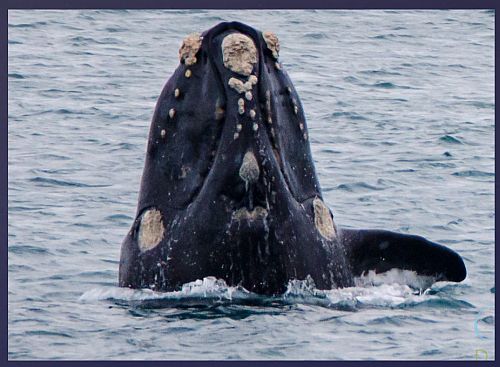
Southern Right Whale with distinctive callosities (white markings) on its head. Whale identified SE1724 ‘Half Moon’ Logans Beach. Image: Coralee Askew, Citizen Scientist.
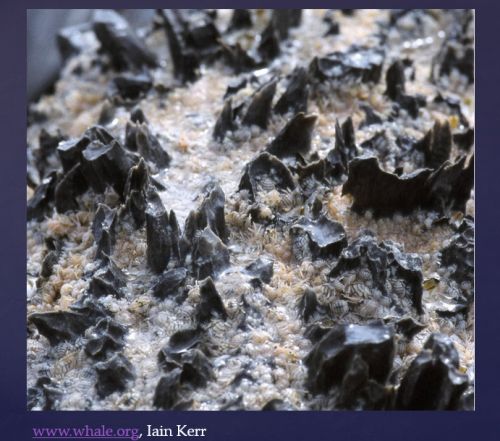
Callosities are made up of colonies of cyamid (whale lice & barnacles). www.whale.org
Photo identification
The south-eastern Australia photo ID catalogue was established in 2002. Most of the identifications are from Victoria with some records from Tasmania, New South Wales and Queensland. Targeted flights were used to obtain most of the data.

Citizen Science 2017
Contributions from community whale watchers started in 2007, mainly around the Logans Beach whale watching platform. With advances in digital photography whale watchers have been able to play a role in providing a number of images which assist in photo ID.
The 2017 season had an increased participation in which Citizen Science played a role in locating and recording Southern Right Whales and providing images so they could be analyses for the photo ID Catalogue.
- 32 individual whales were identified from images. About half from Remotely Piloted Aerial Systems (RPAS) study and the other half from Citizens Science.
- 28 new whales and 4 re-sights including - Logans Beach regular breeding females (Big Lips - 6 calves, Long Coaming - 5 calves, Thin Lips - 2 calves, No Lips Black - 1 calf).
- 56 sightings events contributed by citizen’s science – mostly emailed images.
- 25 members of the whale watching community from Victoria, South Australia and NSW.
- This data resulted in 16 new whales for the catalogue plus 36 documented sightings of 18 of the 32 new whales.
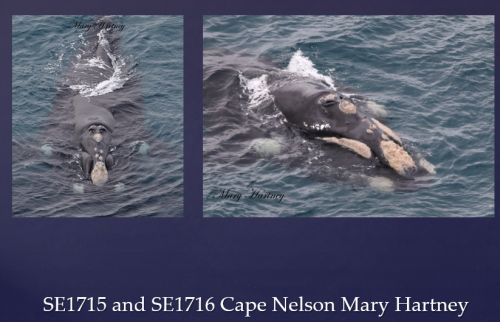
Citizen Science contributing images to assist Southern Right Whale identification.
Mandy commented on the fact that people have become more aware of the type of images needed to identify whales by ensuring they capture the callosities at the right angle to enable identification. Overall, the contribution from Citizen Science has been very good and helped to expand the catalogue.
The next steps
The project can build on the 2017 experience and encourage increased participation from the community. A generic email address will be established or contributors. Mandy is considering a Facebook page to expand community contributions. There is also the possibility of running training workshops.
Key points from general questions
A point was made that there are instances where people have become involved in a Citizen Science project for the wrong reason, only to gain information regarding species locations for illegal purposes. Further consideration of this point is required in development of projects relating to high value species.
In relation to ARI projects, contact and engagement of Aboriginal organisations is determined by the type of project being undertaken. There are many cases where Aboriginal owners have been involved in projects.
There is an opportunity to promote and grow community participation in projects via SWIFFT and Visualising Victoria’s Biodiversity.
KEY POINTS SUMMARY
| Rewilding the Desert incorporates Citizen Science and provides opportunities for people to engage with nature. |
| NatureWatch brings together land managers, scientists and the community to initiate, develop and implement their own community lead Citizen Science projects. |
| The Australia Citizen Science Association (ACSA) aims to advance citizen science through sharing of knowledge, collaboration, capacity building and advocacy for citizen science. |
| Arthur Rylah Institute and Monash University students studied some of the motivations for people to get involved in Citizen Science and ways to increase the reach for connecting people with nature. |
| The Victorian Environmental Flows Monitoring and Assessment Program involves anglers as Citizen Scientists through collection of Otoliths from fish. |
| The 2017 Southern Right Whale season had an increased participation in Citizen Science helping to locate and recording Southern Right Whales for the photo ID Catalogue. |
See notes from other SWIFFT video conferences


